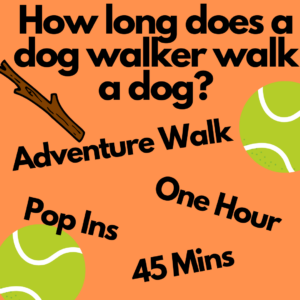Owners very rarely time their walks. They usually have a route and a routine, so when they book a professional dog walker, they may not know how long a dog walker walks a dog. So, how long does a dog walker walk a dog?
Offering a selection of options and planning your day around your client’s needs, may well gain you much more work, a wider client base and a more variable schedule for you than just offering a set, one hour group slot.
So if your two or three daily group walks are starting to feel a bit repetitive, maybe it’s time to rethink.

Table of Contents
Adventure walks
These are for your energetic, fit and healthy dogs in their prime.
Usually, 2 hours or more, travel somewhere further than usual and carry a premium price for this premium service.
Many walkers start offering these as weekend specials maybe once or twice a month to add some extra income. Plus, if you were taking your own dog for a decent weekend hike then why not take 2 or 3 more and get paid for it?
1 hour
A one hour walk is the industry standard, whether solo or in a group.
As a rule of thumb, every one hour walk takes around 90 minutes from your day with collecting and dropping off.
Many new dog walkers will accept any client who enquires but it’s worth considering how far is too far for you. In a rural area, you might have to extend your radius in order to get a group walk together, in a city you may be able to do the same within a few streets of your house.
The rural walker’s group will take longer to collect and use more fuel, so correctly pricing your services are key to making it a long term business. It may take you 30 minutes longer to earn the same amount as a city walker, so it’s only fair that you’re paid for that time.

45-50 minutes
If you offer solo walks as part of your business I would highly recommend making then 45 minute walks.
This gives you time to travel between clients and should enable you to fit in an extra hour to your day.
Purely offering solo walks makes earning a full time living from dog walking harder, but not impossible. Pricing is key to this. You’re offering a 1 to 1 service, giving a dog your full attention and often helping the owner out by following a training schedule on walks (a lot of solo walks are reactive dogs) and that should attract a premium price tag.
30 minutes
Thirty minute walks are a great thing to offer to puppies who are past the pop in stage but not yet old enough for an hour’s walk and have occasional accidents which need cleaning up.
They are also great to offer older dogs with mobility issues who can no longer cope with a full hour.
Clients who ask for shorter walks are difficult to fit in around the lunchtime peak period and yet almost always ask for lunchtimes. I found a small discount can encourage them to be more flexible about timings.

Puppies
Puppies will almost always start with pop-ins, one before your daily group walks and once afterwards. This is a great way to get to know the dog, bond and even get them used to sitting in your vehicle and all the smells etc.
The well-known rule of thumb for walking puppies is 5 minutes per month of age which makes dogs a year old before they can join your group walks. The rule is aiming to minimise any stress on their growing joints by over-exercising them before they’re fully grown.
So what age can a dog go with a dog walker? I would make a judgement call based on two things. Firstly, the size of the dog. Smaller dogs become full sized faster so less danger of damaging joints. For example, I would be inclined to take out a cockapoo at 6 months but would leave a labrador a few extra months. Or you could use a sling to carry them for some of the walk.
Transitioning from pop-ins to solo walks before joining groups can be useful not only for the dog but also for you to convince the owner to delay group walks for a month or two. It’s easy to slow down a solo walk and do a bit more sniffing rather than the full-on hours worth of off lead excitement that a group walk tends to be for a newcomer. It also gives you a chance to test/teach their recall and removes the stress involved when you have to spend time cleaning up their ‘accident’ in the house when you have more dogs in the vehicle waiting to go home.

Senior dogs
As you grow your client base and your regulars begin to age you may notice some dogs starting to slow down as they get older. Because we see so many different ages of dogs and have such a mix in groups, we’re likely to be the first to notice the ageing process affecting them.
If you find yourself waiting for a particular dog to catch up, or perhaps they start to get a little grumpy with the younger ones, it might be time to transition them onto solo walks or pair up with another older dog if you have any.
Pop ins
Puppies, senior dogs and newly adopted dogs can be offered pop-ins. A quick ten to 20 minute visit without a walk just to check on them, clean up, feed if asked and a general welfare check.
How often should a dog walker visit?
Adult dogs need to relieve themselves a minimum of four times a day so having one walk or pop in to break up a twelve hour day is sufficient.
Puppies and older dogs with more complex needs may need checking in on more often and would need two visits in the same time frame.
Do dogs need days off from walking?
If your clients are active at the weekends with their dogs it may do the dog some good to decompress and rest for a couple of days each week. Just like humans, dogs’ bodies need rest to repair and grow muscle after exercise.
Conclusion
Offering several different services which match with a dog’s particular life stage should mean that you’ll be able to provide a service to that dog throughout its life. From puppy pop-ins to solos, groups, then back to solos and pop-ins over the years. Match your service to the client’s needs and you’ll have a client for life.
How to start a successful dog walking business (2023)
AFFILIATE DISCLAIMER
The dog walking coach website is supported by our visitors. Some of the product links on this website are through affiliate schemes such as Amazon. This means that I earn a small commission if you choose to purchase something at no extra cost to yourself.
